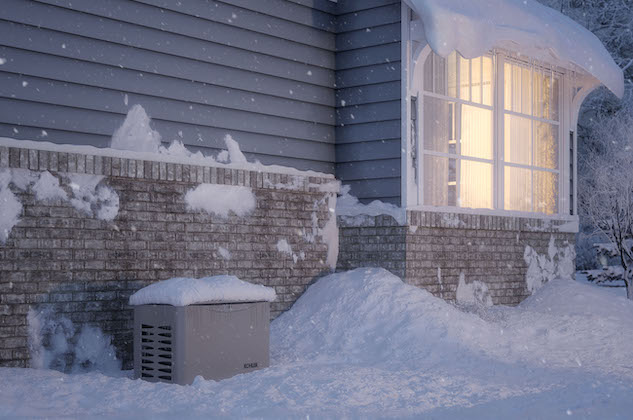7 Generator Maintenance Tips for Winter
Posted by Kristopher Schwind

News of impending winter storms can be daunting, and the potential loss of heat and power creates a major threat to both residences and businesses alike.
Generators can help mitigate this danger, but they’re not a magic solution. You can’t just wave your wand or sprinkle some fairy dust, and expect your generator to work perfectly at the drop of a magician’s hat.
Your generator needs maintenance, even in the cold winter months, to function properly, and the longer you leave it sitting untouched, the less reliable it becomes.
Follow our maintenance tips to keep your generator running effectively throughout the winter and into the warmer weather.
1 – Stabilize Your Fuel
If your generator is in storage for the winter, you’ll want to stabilize the gas with a fuel stabilizer, which is a liquid solution that keeps your fuel fresh during storage. You’ll want to rotate your fuel supply by emptying out old fuel and pouring in fresh gasoline to maximize the life of your generator. Stabilizers work to extend the life of your fuel, so that you’ll have reliable power when you do turn your generator on again.
2 – Change the Oil
Just like your car, your generator needs clean oil to run. And since oil tends to accumulate build-up, you’ll want to make sure it’s changed at approximately 50-hour intervals, and that the filter is changed at 100-hour intervals.
You should also keep a close eye on your oil levels to ensure your generator has sufficient oil to function properly.
3 – Conduct Regular Maintenance Checks
You shouldn’t wait until the next power outage before giving your generator a once-over. Instead, you’ll want to conduct more regular generator maintenance checks and pay particular attention to the oil, fuel, and filters to ensure that your generator is well-lubricated and running as it should. If you don’t, you run the risk of your generator not working efficiently, or worse, not turning on at all.
Check out our exclusive Homeowner’s Guide to Maintaining & Troubleshooting Your Residential Standby Generator as a comprehensive maintenance guide.
4 – Consider a Transfer Switch
For safety throughout the winter months, you’ll want to consider getting a transfer switch, which is an electrical device that allows you to safely connect a generator to your household wiring. A transfer switch prevents the utility power and the generator power from sharing household circuits at the same time.
When engaged, a transfer switch isolates the generator power from the incoming utility lines and serves to safeguard the generator while eliminating the inconvenience of running multiple extension cords from the generator into the house. Having a transfer switch also eliminates the risk of back-feeding the electrical utility, which can cause injury to utility workers as well as property damage.
Just be sure to contact a professional technician to install your generator switch for you; do not attempt to do so on your own.
5 – Provide a Clear Area
Your generator needs to ventilate so that it can work correctly, so it’s important to clear the area around your generator from any debris such as leaves or snow that may have built up during the cold weather.
If it has snowed recently, you’ll also want to create a clear path to your generator by shoveling or snow blowing. This will create easy access to it should a generator technician need to perform any repairs, maintenance, or even emergency service.
6 – Exercise Your Generator
You’re not the only one who needs to keep things moving to stay healthy – your generator needs regular exercise as well! Sure, you’re not going to throw your generator on the treadmill or ask it to drop and give you twenty, but you should run it for about ten minutes after long periods of inactivity during cold weather.
Just as bodies become more inflexible with lack of use, your generator may not turn on or operate correctly in temperatures lower than forty degrees Fahrenheit without proper use. The best way to give your generator the boost it needs is by letting it run about once a week for approximately ten minutes to lubricate all its moving parts.
By performing regular checks on your generator and giving it the attention it needs, it can in turn provide you with years of reliable power.
Kristopher Schwind is the proud owner of National Standby Repair.
 24/7 EMERGENCY GENERATOR SERVICE
24/7 EMERGENCY GENERATOR SERVICE REQUEST A QUOTE
REQUEST A QUOTE
 (914) 734-1400
(914) 734-1400